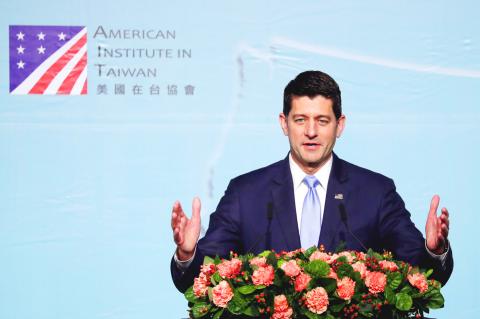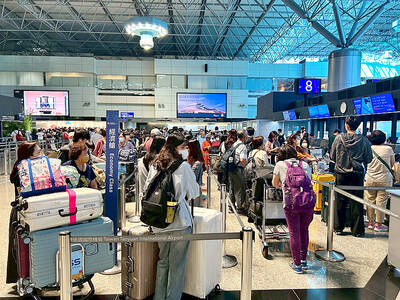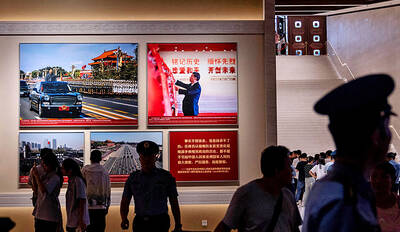The most destabilizing element of cross-strait relations is China’s refusal to renounce the use of force against Taiwan, former US House of Representatives speaker Paul Ryan said yesterday in Taipei.
“I think it is self-evident that perhaps the most destabilizing element ... of cross-strait relations is Beijing’s refusal to renounce the use of force to achieve its goal of unification,” Ryan said in his keynote speech at the one-day Indo-Pacific Security Dialogue.
He cited as examples Chinese military aircraft circling Taiwan at least 20 times since November 2017 and two Chinese fighter jets crossing the median line in the Taiwan Strait late last month for the first time in two decades.

Photo: Ritchie B. Tongo, EPA-EFE
The latest such action occurred on Monday, when a US delegation headed by Ryan arrived in Taiwan to celebrate the 40th anniversary of the implementation of the US’ Taiwan Relations Act and the establishment of the American Institute in Taiwan (AIT) at a banquet in the AIT’s new compound in Taipei’s Neihu District (內湖), which is to officially open on May 6.
“The world is watching whether Beijing treats Taiwan with the dignity and the respect that it deserves. And make no mistake about it: This is a crucial test [of] whether China is qualified to take on the leadership role internationally that it believes is befitting its size and stature,” Ryan said.
Committing to a peaceful dialogue would be the first and most important step for Beijing to demonstrate to a “skeptical world” that “China can lead in an aspiring and benevolent fashion,” Ryan added.
“So I urge Beijing to choose the path of peace, the path of respects [and] of civility, by resuming dialogue with Taiwan’s democratically elected administration,” he said.
The US’ policy of supporting Taiwan’s defensive needs has been consistent across seven US administrations, AIT Director Brent Christensen said, adding that both major political parties in the US have helped foster Taiwan’s prosperity and democratic development.
“The US’ vision for a free and open Indo-Pacific dovetails neatly with our security cooperation with Taiwan. This vision promotes stability and security cooperation across the Indo-Pacific region to ensure that all parties are free from external coercion,” Christensen said.

Three batches of banana sauce imported from the Philippines were intercepted at the border after they were found to contain the banned industrial dye Orange G, the Food and Drug Administration (FDA) said yesterday. From today through Sept. 2 next year, all seasoning sauces from the Philippines are to be subject to the FDA’s strictest border inspection, meaning 100 percent testing for illegal dyes before entry is allowed, it said in a statement. Orange G is an industrial coloring agent that is not permitted for food use in Taiwan or internationally, said Cheng Wei-chih (鄭維智), head of the FDA’s Northern Center for

The Chinese military has built landing bridge ships designed to expand its amphibious options for a potential assault on Taiwan, but their combat effectiveness is limited due to their high vulnerability, a defense expert said in an analysis published on Monday. Shen Ming-shih (沈明室), a research fellow at the Institute for National Defense and Security Research, said that the deployment of such vessels as part of the Chinese People’s Liberation Army (PLA) Navy’s East Sea Fleet signals a strong focus on Taiwan. However, the ships are highly vulnerable to precision strikes, which means they could be destroyed before they achieve their intended

About 4.2 million tourist arrivals were recorded in the first half of this year, a 10 percent increase from the same period last year, the Tourism Administration said yesterday. The growth continues to be consistent, with the fourth quarter of this year expected to be the peak in Taiwan, the agency said, adding that it plans to promote Taiwan overseas via partnerships and major events. From January to June, 9.14 million international departures were recorded from Taiwan, an 11 percent increase from the same period last year, with 3.3 million headed for Japan, 1.52 million for China and 832,962 to South Korea,

REWRITING HISTORY: China has been advocating a ‘correct’ interpretation of the victory over Japan that brings the CCP’s contributions to the forefront, an expert said An elderly Chinese war veteran’s shin still bears the mark of a bullet wound he sustained when fighting the Japanese as a teenager, a year before the end of World War II. Eighty years on, Li Jinshui’s scar remains as testimony to the bravery of Chinese troops in a conflict that killed millions of their people. However, the story behind China’s overthrow of the brutal Japanese occupation is deeply contested. Historians broadly agree that credit for victory lies primarily with the Chinese Nationalist Party (KMT)-led Republic of China (ROC) Army. Its leader, Chiang Kai-shek (蔣介石), fled to Taiwan in 1949 after losing a